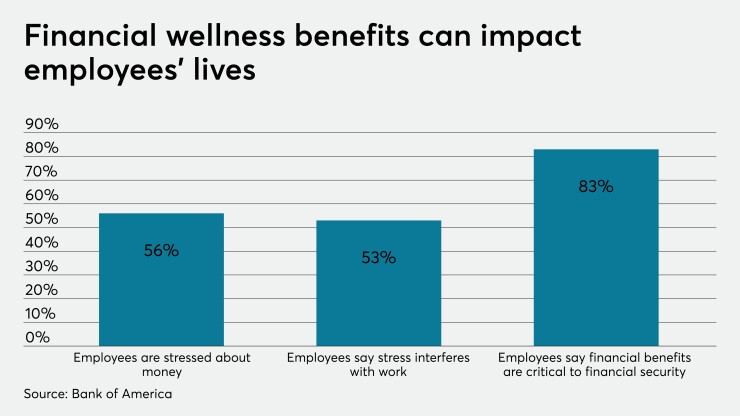Financial wellness benefits aren’t just a “nice to have” anymore. The skyrocketing popularity of this holistic approach to employee benefits presents a challenge — and an opportunity — for benefits administrators who always need to make sure their plans target the intersection of participant expectations and company needs.
More nuanced than traditional benefits, financial wellness encompasses employee mental stress related to all aspects of personal finances, and mandates employers to provide support. But rather than simply adding a new product or vendor to your offerings, consider a gut check on vision: Are you positioned to help address the complete range of participant financial, mental and physical health needs? If not, your bottom line may be poised for pain.
Dollars and stress
In a 2019 MetLife report, one in three employees said that personal financial stress interfered with their job performance — and overall, employees flagged personal finance as the main source of stress in their lives.
Employers reported a loss of $250 billion in 2019 due to employee stress. It’s estimated that financial stress costs roughly 1,922 hours and $28,830 in lost weekly productivity in a company of 10,000 — that’s 99,944 hours and $1,499,160 a year down the drain.
Untapped resources
The key lies in understanding the needs behind the financial stress employees feel so keenly.
Not having an emergency fund is the top cited worry for Millennials and Gen Xers, while half of all employees across generations live paycheck to paycheck. Employees clearly see benefits as an answer for at least some of their problems: 37% of Millennials said student loan repayment was the perk they most wanted from employers, while 30% of Gen Xers and 28% of Baby Boomers most wanted financial wellness benefits with access to financial counselors.
From short-term budgeting to long-term saving — and everything in between — participants are looking to their benefit plans for help. Increasing participant offerings and promoting engagement could be a powerful step toward helping participants achieve their financial goals.
How plan administrators can answer the call
Benefits administrators are uniquely positioned to put game-changing tools and options into the hands of their participants, but it takes careful preparation.
Financial wellness is not a one-size-fits-all solution: While it’s clear most employees share the desire for financial wellness benefits, there’s no single product or service that can address every individual’s unique combination of financial stressors. Rather, the goal should be to thoughtfully provide options, along with support so participants can choose a frictionless path forward.
Employee assistance programs, student loan repayment and refinancing, 529 (education savings) plans, budgeting and financial planning support — it’s likely your participants are looking for one or all of these resources. These steps can help you bridge the gap between your current offerings and participant financial wellness needs:
Assess needs and wants: To reach your participants, you first need to figure out what they need. Start with gathering data: What are your participants asking for? What are their goals? What are their primary financial stressors? It may be time for a survey to gauge the mindset of your participants, identify priorities, and establish benchmarks against which you can later measure the ROI of any changes you make to your plan.
Identify your unique prescription: A whopping 80% of employees want financial planning workshops or financial wellness tools from their employers, but only 20% of employers offer these programs. Providing education and advice may be a good place to start, but don’t forget to take a hard look at products, services, and relationships with outside vendors. While the vast majority of employees wish their companies offered student loan repayment benefits, only 4% of them do.
Implement wider-ranging options: Identify strategic updates you can make to your existing benefits program. From long-term savings help (auto-enrollment or auto-escalation features) to short-term budgeting and debt-planning support (access to professional investment advice and guidance), the key is to understand that your participants most likely want a diverse array of options. You may also consider adding new plan features to address specific employee benefit asks, such as student loan repayment or 529 plan contribution matching.
Educate and engage with participants: Make sure your participants know about any new benefits, self-teaching tools, support opportunities, or enrollment options. Deliver an experience that allows participants to view these important benefits in one place and receive a more comprehensive picture of their workplace solutions. Education and engagement initiatives can make all the difference. In a crowded space, the last thing you want is for participants to miss out on your carefully thought-out wellness benefits just because they aren’t aware or don’t understand what’s available.
Remember, financial wellness is about supporting participants on the path toward their personal financial goals. Stay in tune with your participants throughout the process of assessing and updating your benefits, from initial data gathering to promoting awareness and engagement. Your support of your participant’s physical, emotional, and financial health will pay dividends in engagement, productivity, and employee satisfaction.






